Trees in Utah can be afflicted by several different fungal diseases. Many of these are brought on by the wet, cold conditions during the onset of spring. This has been the theme of 2023, so you may be seeing the signs of fungus in or on your trees already.
When blotches appear on the leaves or bark of your favorite tree, it can be difficult to tell what tree disease is the problem. Here is a list of some of the most common fungal tree diseases in Utah and what you can do about them.
Do your trees have withered leaves or blotches you can’t identify? Set up a free, no-obligation consultation with one of our certified arborists.
Anthracnose
Maple, ash, sycamore, and oak are the victims of anthracnose, a fungal tree disease common in Utah. This fungus thrives in cool, wet springs, such as the one we have had in 2023.
To propagate, the anthracnose creates spore-bearing acervuli, structures that erupt inside the tissues of the affected tree. The wounds present as small dots along the main veins in a tree’s leaves and twigs, as well as splitting bark. These places are breeding grounds for the spread of fungal growth. Severe infections can cause a tree to lose its leaves as early as midsummer.
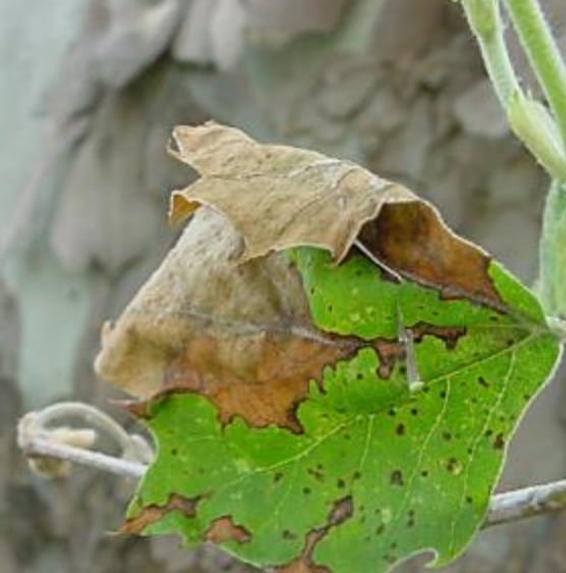
How to Treat Anthracnose
Prevent the further spread of this fungus by pruning affected branches, raking up fallen leaves, and burning them. Nourish the tree with adequate water and fertilizer to ensure its continued growth. Fungicides may also help combat anthracnose and should be applied early in the season, particularly in spots that tend to see cool, wet spring weather.
Aspen Leaf Spot
Utah’s forests and neighborhoods are dotted with the iconic sight and sound of aspen trees, or “quakies.” However, some of these beautiful trees are afflicted with aspen leaf spot, which causes dark spots on otherwise brilliant green and yellow leaves. The cause is the fungus Marssonina. Apart from producing unsightly spots, this fungus can cause the tree to defoliate early.
The fungal infection starts in the spring when it is carried by wind and rain to host trees. Small brown dots occur on the leaves, which grow into large blotches and may create acervuli. The white spots inside these structures burst out and carry the infection to new sites.
How to Treat Aspen Leaf Spot
Rake up and dispose of any infected leaves. Make sure your sprinkler isn’t hitting leaves and creating moist spots where this fungus can thrive. When you are planting aspens, make sure that they are far enough apart so that air and moisture don’t get trapped between them. Prune existing trees to ensure that they get enough circulated air. You can also use a fungicide in wet, spring weather (this is unnecessary during dry times of the year).
Note that aspen leaf spot can look very similar to iron chlorosis, and they can occur simultaneously in a tree. A certified arborist can inspect your tree t[1]o determine whether it has one or both of these problems and recommend the proper treatment.
Dothistroma Needle Blight
Pine needles turn brown and drop for a number of reasons, and one of them is dothistroma needle blight. This fungal tree disease causes needles to turn brown from tip to branch with a characteristic red band that divides the brown and green portions of the needles. The brown portions then fall off.
New infections usually show up in the late summer to early fall, but trees with recurring instances of this disease will host half-brown needles and small, black spots on the needles (which contain the fungal spores) at any time of the year.
Ponderosa and Austrian pines are the most susceptible species, but other conifers may be affected as well.
How to Treat Dothistroma Needle Blight
Trim conifers so there is plenty of space between trees and branches for air to circulate. When you plant new trees, make sure they are not crowded. If you use mulch, leave a few inches of space between the mulch and the tree trunk. Do not allow water from sprinklers or irrigation systems to contact the needles
Copper-based fungicides can help susceptible conifers recover from dothistroma needle blight and prevent new infections.
Cytospora or Perennial Canker
This fungus affects a wide range of trees, including stone fruit trees (peach, plum, apricot, and cherry), as well as willows, birches, poplars, aspens, and more.
This infection usually starts from a wound to the tree, such as a broken branch, frost damage, insect infestation, or even pruning cuts. Cytospora mainly affects distressed or weakened trees. Cankers spread from their entry point, weakening the tissue and causing it to turn sink in and change color.
In addition to cankers, your tree’s bark may look like it’s covered in blackheads or acne. These are pycnidia, structures that exude orange ribbons of spores during warm, wet weather. These are carried away with the wind or rain to infect other trees.
How to Treat Cytospora
Unfortunately, fungicides are not effective against cytospora after an infection has gained hold. Prevention is your best bet to keep your trees healthy. Prevent any damage to the tree from machines, mowers, etc. When you prune, make sure to do it when there is no danger of rain. Trim away any infected twigs or branches, and control any boring insects that might leave an entry point for infection.
Oak Leaf Blister
Wet springs can bring on many different fungal tree diseases in Utah, and oak leaf blister is one of them. This fungus affects over 50 species of oak, the most susceptible of which grows all over the Wasatch front — scrub oak.
Oak leaf blister starts by entering the tree via buds and bud tissue, infecting the leaves as they grow. The good news is that leaves are only infected in cold, wet spring conditions, and secondary spreading throughout the year isn’t a problem. The bad news is that once the brown lesions are present on the leaves, it’s too late to control the infection.
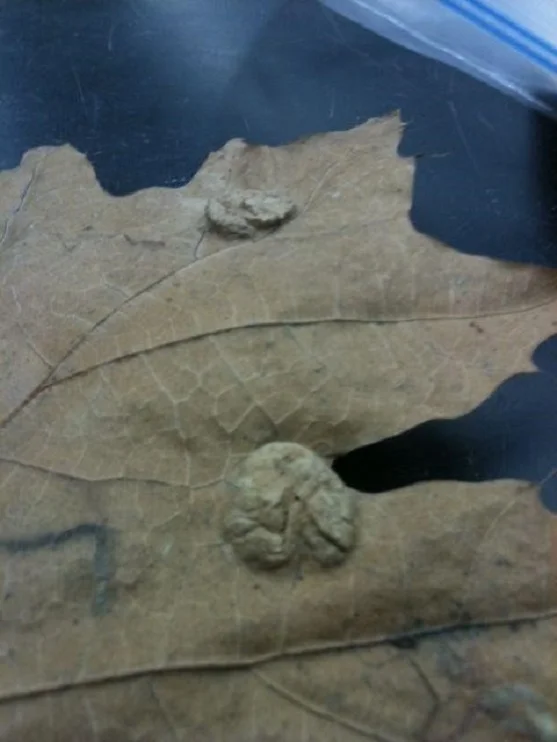
Taphrina caerulescens. (2022, October 21). In Wikipedia. https://en.wikipedia.org/wiki/Taphrina_caerulescens
How to Treat Oak Leaf Blister
Most treatment for this tree disease is precautionary. Raking up leaves (to reduce the chance of the fungus growing nearby) and applying fertilizer to strengthen the tree are proactive things you can do to prevent oak leaf blister and other problems. Because oak leaf blister doesn’t usually do lasting damage to its hosts and because it only infects once a year, chemical treatment is not usually recommended.
Coryneum Blight (or Shothole Blight)
This fungus commonly affects stone fruit trees, such as peaches, apricots, and nectarines. Though signs of infection pop up between the spring and fall, the fungus overwinters in the twig and bud tissue. Like most other fungal infections, Coryneum blight thrives in wet conditions and is carried by water to leaves. The key symptom is small red spots that show up on leaves, which wither and drop out, leaving them looking like they’ve been shot through. Purple or red scabs can also affect the fruit of an infected tree.
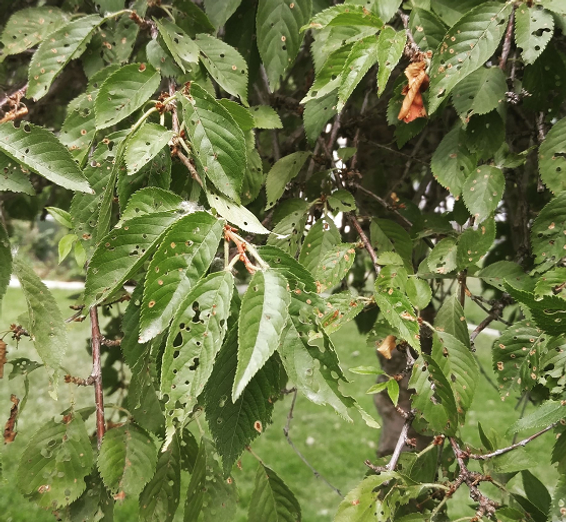
How to Treat Coryneum (Shothole) Blight
Treatments for this disease include Bordeaux mixture or copper sprays in the fall to prevent the fungus from surviving in the twigs. If your tree is infected, it’s also best to trim and dispose of infected wood.
Tree Diseases That Aren’t Fungal
Not all tree diseases are caused by fungi, but many others share symptoms with fungal tree diseases. Here are a few other common tree ailments you’ll find in trees in Utah.
Iron Chlorosis
This problem isn’t a disease, but rather a nutrient deficiency where the plant doesn’t receive enough iron. There is plenty of iron in Utahn soils, but because they are alkaline, the iron is insoluble and unusable for trees and other plants. A big contributing factor is the lime in the soil, which is abundant in many parts of Utah.
Many trees, particularly maples, oaks, aspens, some fruit trees, and pines, are especially susceptible to iron chlorosis. Their leaves turn pale (yellow for green leaves, pink or reddish for purple ones) long before the fall. The leaves of drought-stressed trees that suffer from severe iron chlorosis may die off during hot periods in the summer.
Iron chlorosis can affect portions of the tree or the entire thing. Because iron uptake is necessary for chlorophyll production (the substance responsible for photosynthesis), the tree can die if it suffers from iron chlorosis for a long time.
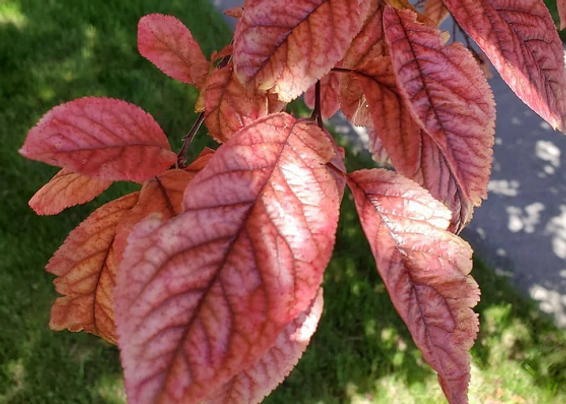
How to Treat Iron Chlorosis
Prevention is the best treatment for iron chlorosis. This involves choosing cultivars that are resistant to this problem, as it is easier to change your trees than it is to change the soil they grow in. For existing trees that show signs of iron chlorosis, maintain a watering schedule that wets the tree and its roots and allows the soil around them to dry before watering again; overwatering exacerbates the problem.
Soil additives may be used to make iron more available to struggling trees and plants. Contact a certified arborist to help you select a soil amendment to treat iron chlorosis in your trees.
Leaf Scorch
Leaf scorch is not caused by a fungus but rather by the trees’ inability to uptake enough water to transport them to the leaves in the top branches. Hot, dry, windy conditions (like the ones Utah has seen for many years) are a common culprit, but an injury to the roots, compacted soil, and girdled roots can also prevent water uptake, scorching the leaves.
Many years of drought stress or insufficient water can cause the upper canopy to die off. While leaf scorch can affect any plant, trees such as maples, elms, chestnuts, poplars, and other species with broad leaves are commonly affected.
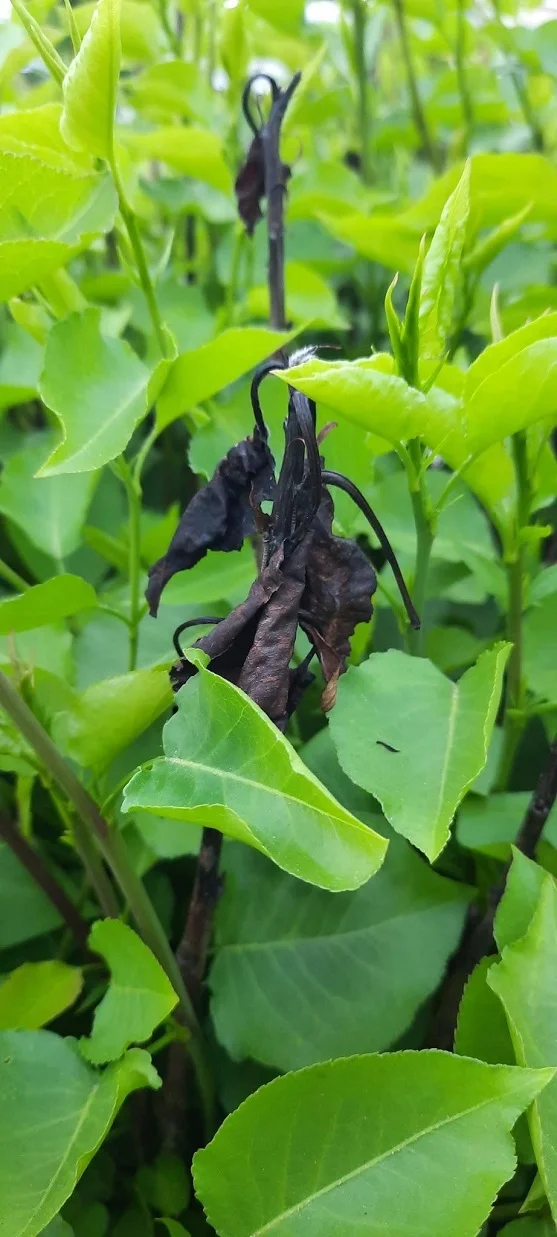
How to Treat Leaf Scorch
Trees with leaf scorch simply need to be watered correctly. Use a drip or soaker hose to water your tree; water from a lawn’s sprinkler system is likely insufficient. Water deeply once every week or two, depending on the age of the tree and whether there are drought conditions. Add 2 to 3 inches of mulch under the tree (but not against the bark) to retain more moisture in the soil.
Fire Blight
This bacterial tree disease can affect a number of different trees and shrubs in Utah, but it’s most common in mountain ash, pear, crabapple, and apple trees. Affected trees often have withered leaves and shoots, looking like they were scorched by fire. Young leaves and shoots curve down and turn grayish. Withered flowers, leaves, fruit, and shoots can cling to the tree for months. The infection often moves from the leaves or branches down to the trunk through the tree’s vascular system.
Fire blight bacteria live on cankers on the trunks or branches of infected trees. Due to spring warming, these infections create a sweet sticky ooze that attracts pollinators who unwittingly carry the bacteria to flowers and other trees. Splashing rainwater and contaminated gardening tools can also spread the disease.
How to Treat Fire Blight
To treat an infected tree, the diseased wood needs to be pruned, ideally during dormancy. Burn or dispose of infected wood in the trash to avoid spreading the disease to other parts of the yard. Bactericides can help fight infections in the flowers, particularly during a rainy spring.
Certified Arborists Can Diagnose Fungal Tree Diseases
Most backyard gardeners know when their tree is sick, damaged, or dying, but it can be hard for the layman to determine the cause of the problem. If your trees are experiencing any of these symptoms, give Rivendell Tree Experts a call.
Our team of certified arborists can diagnose what’s ailing your tree, whether that’s a fungus, bacteria, or improper soil nutrients. Give us a call for your free, no-obligation quote today!



